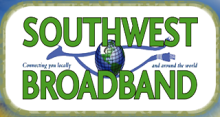WindomNet Turns on Southwest Minnesota Broadband Services
Exciting times in rural southwest Minnesota, as Southwest Minnesota Broadband Services has turned on its first customer. SMBS is a broadband stimulus-enabled partnership with eight rural communities and WindomNet, the muni FTTH network in Windom.
The Rev. Andrew Schensted and his wife, Lisa, were the first to be connected. The fiber-to-home connection provides “obnoxiously fast Internet,” Andrew Schensted said in a SMBS press release. The SMBS Internet is “at least 10 times faster” than what they had when living in the metropolitan area, Andrew Schensted added. The couple has been able to streaming video in full HD from TV streaming websites.So it begins... the Metro around Minneapolis and St Paul have to rely mostly on Comcast for connections to the Internet. CenturyLink's DSL is generally slower and in many places, utterly unreliable. Monticello has had a blazing fast connection (faster than we can get in the metro) at lower prices for more than a year. Communities served by HBC also have faster connections in SE Minnesota. In the coming year, the stimulus-funded networks on the North Shore will also have better connections than we can get. It will be curious to see how development patterns adjust in the coming years.
“The demand for higher-speed Internet in our rural area is daunting,” Olsen said. “People not only want faster speeds, they need it for their business operations. If the wireless trial is successful, it could provide a better option to those not on the fiber system. “ Southwest Minnesota Broadband Services (SMBS) is a consortium of eight communities including Bingham Lake, Brewster, Heron Lake, Jackson, Lakefield, Okabena, Round Lake and Wilder. The 125-mile, $12.8 million dollar fiber ring is expected to be completed in September 2012. The fiber-optic communication network has the capacity to bring fast, competitively priced services for internet, phone and cable TV to residential subscribers as well as businesses and other community institutions. The government grant-supported project is intended to provide southwest Minnesota with the telecommunications connectivity required to remain competitive in the global marketplace.The new network has bucked a strong trend among community fiber networks of offering symmetric connections to the Internet.



